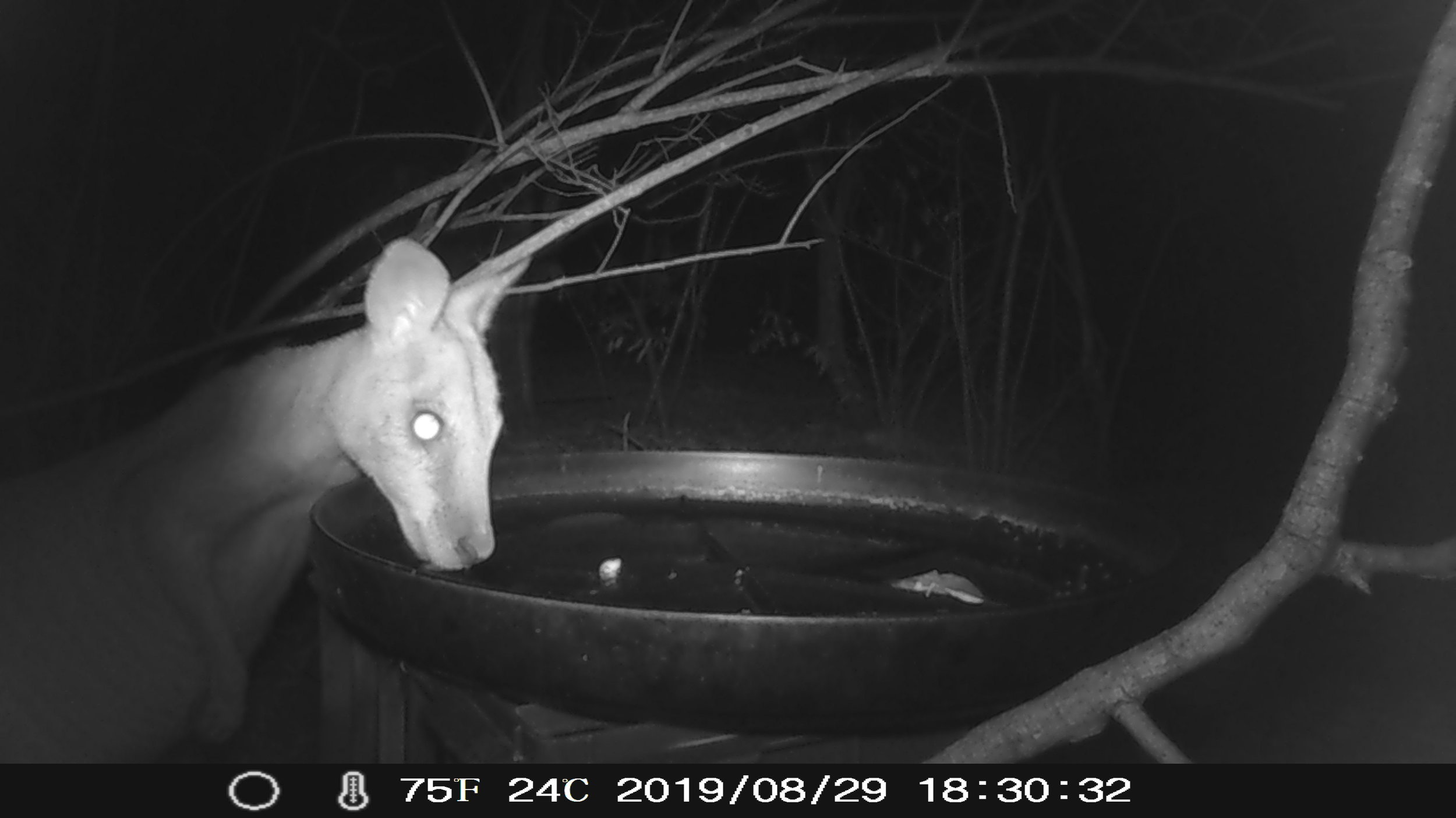The Long Tail of a Camera Trap
After a very dry wet season, the BBO bird baths have seen an influx of some birds (e.g. Australian White Ibis and Yellow-tinted Honeyeater) while other species have been uncharacteristically absent. Long-tailed Finches, for instance, haven’t been recorded at Bird Log since May. Every day at the bird baths for the past few months there has been a flurry of activity with the usual Double-barred Finches and higher than normal numbers of Zebra Finches, but no Long-tailed Finches. And every night at the end of Bird Log for the past few months, a Warden or Assistant Warden has tentatively asked, “Any Long-tailed Finches?” And every night there has been disappointment, although, truth be told, there have been sightings of Long-tailed Finches at water bodies elsewhere within the 70km radius of the BBO but not at the Observatory itself. We questioned whether the birds had moved elsewhere for some reason or whether they were still around and we just hadn’t seen or heard them.
A banded Magpie-lark appears to be on sentry duty at the Wardens’ bird bath.
A Bar-shouldered Dove seems out-of-place as it gate-crashes the finch party.
There is only so much time you can spend bird-watching a day before other commitments tear you away from it. With multiple people bird-watching at various times and places, this increases our chances of ‘success’ at Bird Log but there is still a possibility of birds flying under the radar. The arrival of a cheap camera trap brought with it all sorts of ideas and opportunities. What could we find if we set up a camera that was monitoring an area 24/7 and photographing what moved? As bird baths attract a range of birds, it made sense to have the camera trap face a bird bath. We decided to set it up at the makeshift bird bath beside the Wardens’ house as this location is fairly secluded for the birds (also, the Wardens had been making a list of species that visited their bath throughout the year so hoped the camera would make this easier too). And, of course, one bird we hoped to see was the Long-tailed Finch. We set up the camera to take two photos each time it was triggered and with a 10 second interval between possible triggers. When we checked the camera after two days it had taken around 2000 photos. We pulled the bird bath closer and angled the camera slightly downwards to hopefully reduce the amount of background bush that was within the sensor’s range.
A Yellow-tinted Honeyeater bathes amidst the Zebra and Double-barred Finches. The water smudges on the camera are testament to the energetic bathing of the finches.
A Grey Shrike-thrush peers cheekily at the camera. This is one species yet to be recorded on the Wardens’ bird bath list as the bird must actually be seen to interact with the water. Even the 4 photos taken of it by the camera trap didn’t show it interacting with the water.
Going through the photos of those two and a half days revealed a plethora of birds including Yellow White-eyes, White-gaped, Yellow-tinted and Brown Honeyeaters, Little Friarbirds, Great Bowerbirds, Magpie-larks, Bar-shouldered and Peaceful Doves, and Double-barred and Zebra Finches, as well as some night activity from Agile Wallabies. Most photos were courtesy of the finches that didn’t seem to be able to stay away. As I was skimming through the photos of the third day, an odd-looking finch caught my eye amongst the hustle and bustle of the bathing Double-barred and Zebra Finches. I went back to the previous photo. The grey head, orange beak and black bib was unmistakeable. And then I saw another one in the same photo. We excitedly announced that night at Bird Log that two Long-tailed Finches had been seen at the BBO via camera trap. This changed everything. We knew they were still here; they hadn’t moved on. We watched the bird baths more vigilantly; Nyil spent a good ten minutes watching the Wardens’ bird bath in the hope of catching a glimpse of a Long-tailed Finch amongst the other finches but to no avail. We kept the camera going.
A bird salad - Peaceful Doves, a Zebra Finch and a Yellow-tinted Honeyeater all congregate at the bird bath while Double-barred Finches perch in the twigs above.
An Agile Wallaby sips water but fortunately doesn’t knock over the bird bath (something that frequently happens overnight due to the wallabies).
The next time we checked the camera trap was Saturday night. Saturday had been Nyil’s day off and he’d spent a while lying in the hammock which was in sight of the bird bath and the camera trap. While I was skimming through the photos on Saturday night, our campground host, Dennis, said, “Stop! What’s that bird there?!” It was a Long-tailed Finch looking almost straight at the camera, and what’s more, it had arrived at the bird bath within five minutes of Nyil arriving at the hammock. Sadly for Nyil, he wasn’t looking behind him. I messaged the photo to the Wardens which caused laughter and exasperation the next morning.
If only Nyil had looked behind him at the bird bath…
A second Long-tailed Finch arrives to rub salt into the wound.
Long-tailed Finches have now been recorded on 5 of the 8 ½ days the camera has been deployed but, more excitingly, they have actually been seen and heard the last couple of days, as if the camera trap broke their invisibility spell. We are leaving the camera at the bird bath for a while longer, hoping the camera might capture some other irregularly-seen species, and are pondering our next location for placing the camera. We will keep you updated!
- Mattea Taylor
A gallery of a few of the other birds caught on camera:















